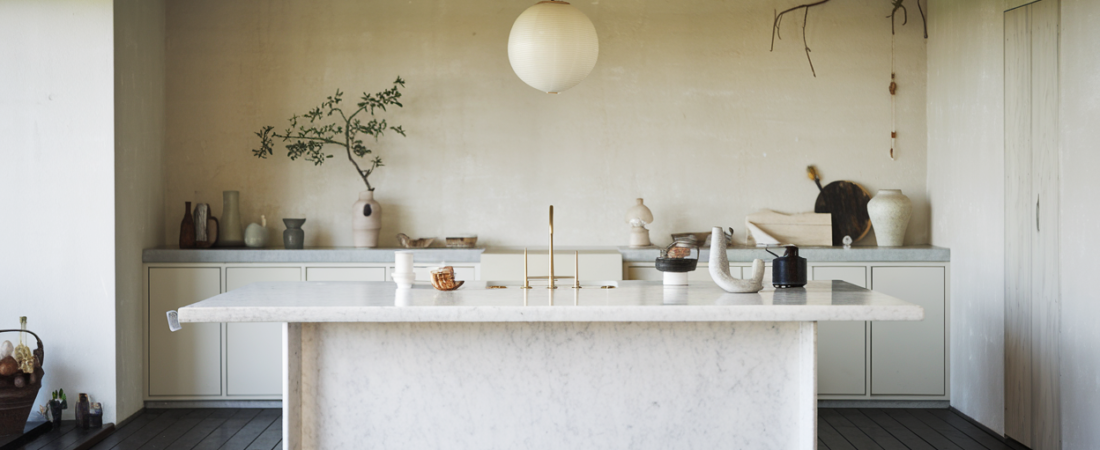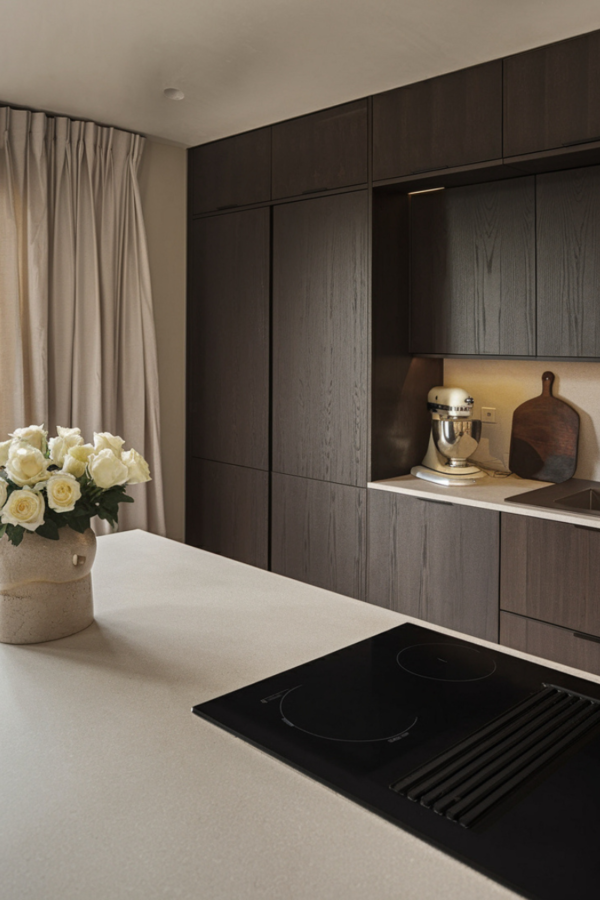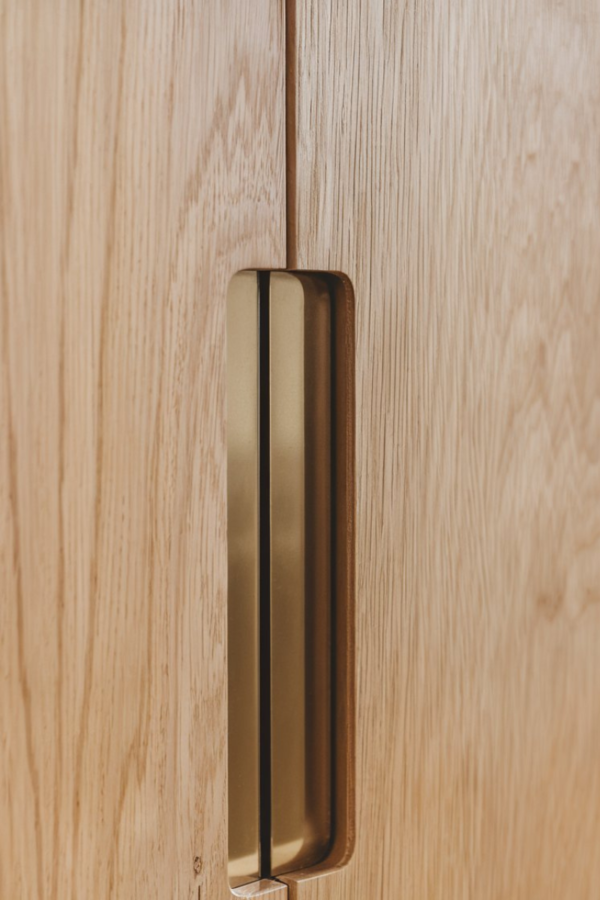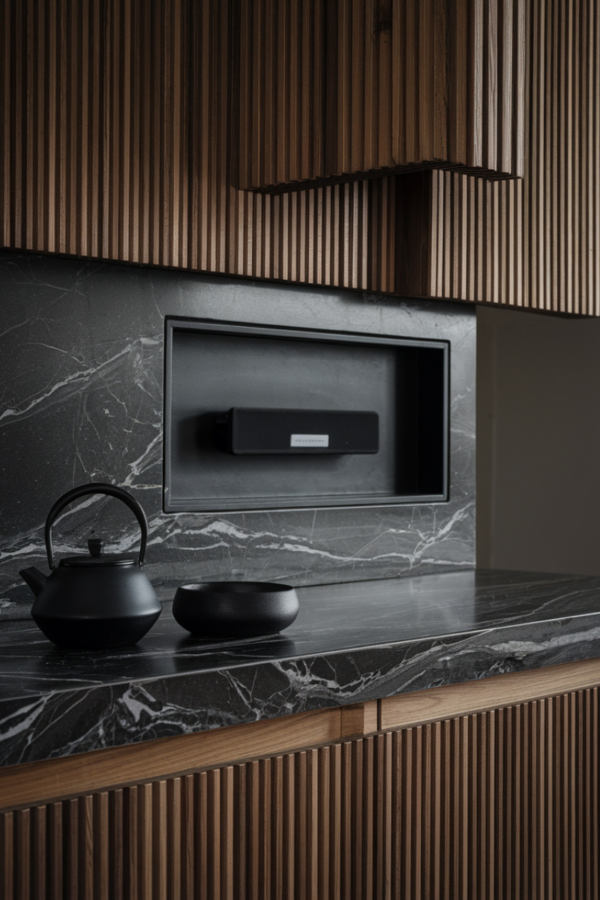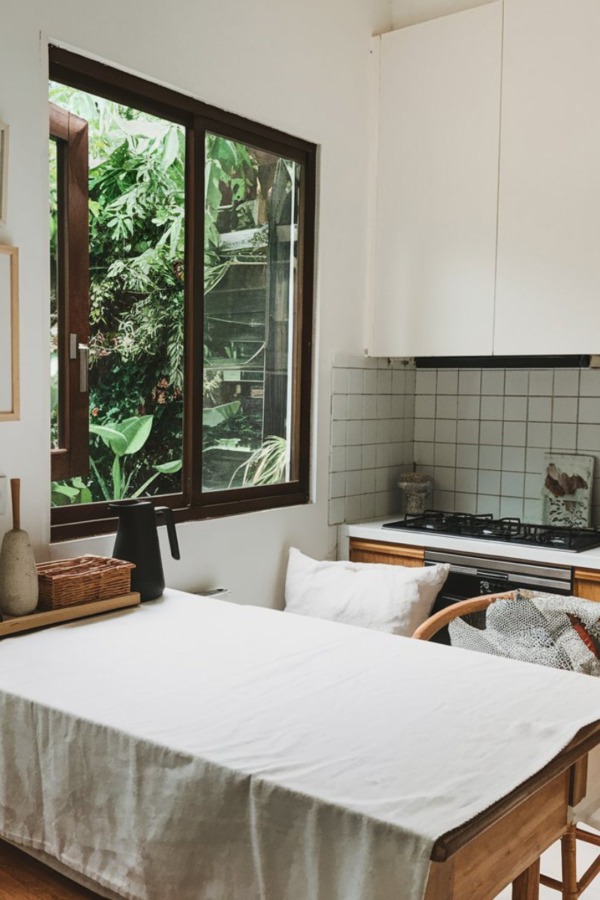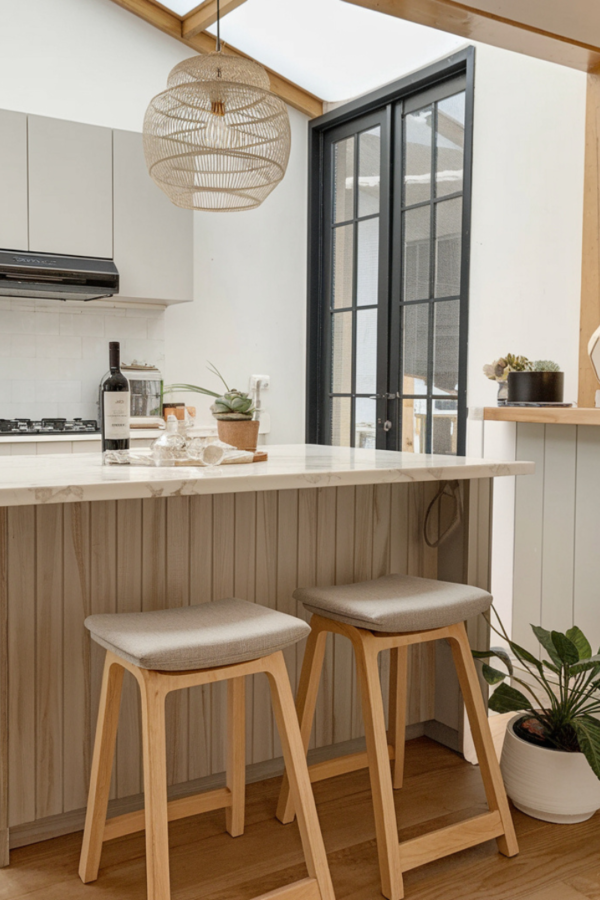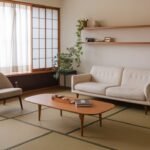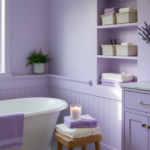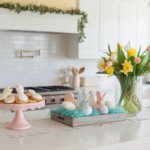A Japandi kitchen just feels different. It’s calm, warm, and effortlessly stylish—where Japanese elegance meets Scandinavian coziness in perfect harmony. Nothing feels excessive, but the space never looks empty. Every detail has a purpose, and somehow, it all works together to create that just right kind of balance.
I didn’t always get minimalism. I used to think it was just an excuse for people to have no furniture and pretend they liked it. Then my brother went to Japan. And let me tell you, I have never heard someone talk about a space with more awe.
He kept coming across these minimalist interiors—clean, uncluttered, simple. But what stuck with him wasn’t just how they looked, it was how they felt. He always knew when something was out of place, yet somehow, it wasn’t stressful. It was the opposite. He could exist in the space, not worrying about keeping things perfect, because the space itself was perfect. It was this middle ground between order and ease, a mental space where comfortable laziness met pure bliss.
No work. No overthinking. Just being. And that’s what Japandi design nails—it strips away the excess but leaves behind everything you actually need.
This style leans into natural textures, a muted color palette, and uncluttered spaces to bring a sense of serenity to your kitchen. It’s the kind of space that makes you exhale when you walk in. It doesn’t demand attention, it just exists—beautifully, effortlessly, and exactly the way it should.
And honestly, who doesn’t want that?
Let’s break down the essentials that make a Japandi kitchen feel like a breath of fresh air.
Essential Japandi Kitchen Elements
Shelves: Open, Minimal, and Functional
Open shelving is a Japandi must-have. It keeps things light and airy while giving you a place to display your prettiest (and most practical) kitchen essentials. But the trick is to keep it curated, not cluttered.
- Stick to natural materials – Light oak, ash, or walnut shelves blend beautifully into the Japandi aesthetic.
- Curate what you display – Neutral-toned ceramics, handmade pottery, and a few glass jars filled with kitchen staples. (If you have mismatched plastic containers, we’ll pretend we didn’t see them.)
- Leave breathing room – Too much on a shelf? Chaos. A little space between objects? Instant calm.
Open shelves aren’t just storage—they’re a way to bring intentional beauty into your kitchen. Plus, they make grabbing that morning coffee mug so much easier.
Cabinets: Streamlined Storage with a Soft Touch
Not everything needs to be on display (we’re looking at you, junk drawer). Japandi cabinets keep things tucked away, ensuring your kitchen stays peaceful, not messy.
- Flat-panel doors = clean and timeless – No fancy molding or ornate details, just smooth surfaces that create a sense of calm.
- Stick to neutral and earthy tones – Warm white, soft beige, sage green, or natural wood finishes keep the space feeling grounded.
- Handleless or integrated pulls – Because nothing says sleek and modern like push-to-open cabinets.
Japandi cabinetry is all about practical beauty—it makes life easier while looking effortlessly put together. Kind of like that one friend who always seems to have it all figured out.
Cabinet Hardware: The Small Details That Matter
Even in a minimalist kitchen, the little details still count. Cabinet hardware might seem small, but trust me, it’s the tiny touch that pulls everything together.
- Simple, but intentional – Matte black, brushed brass, or wooden knobs add a subtle pop without being too much.
- Soft-close hinges are a must – Because a serene kitchen shouldn’t have cabinet doors slamming at 7 a.m.
- Minimal but tactile – Hardware should feel good in your hands. No clunky knobs or awkward handles allowed.
Think of cabinet hardware like the perfect finishing touch on an outfit—small, but so important.
Key Surfaces That Define the Space
Countertops: Simple, Clean, and Durable
Japandi kitchens thrive on uncluttered surfaces, so countertops should be practical, beautiful, and low-maintenance (because no one wants to spend all day wiping up fingerprints).
- Matte over glossy – Less glare, fewer smudges, and way more natural-looking.
- Stone-inspired materials – Quartz, soapstone, and concrete bring a neutral, organic feel that fits seamlessly into Japandi design.
- Minimal but functional styling – A single ceramic bowl, a wooden cutting board, or a linen tea towel. That’s it. (No need to stage a mini farmers’ market on your counter.)
A Japandi countertop doesn’t demand attention—it just belongs. Like it was always meant to be there.
Splashback: Clean Lines with a Natural Touch
A splashback is like the subtle backdrop of a Japandi kitchen. It should complement the space, not steal the show.
- Zellige tiles add organic texture – Their imperfect, hand-glazed finish brings just the right amount of character.
- Stick to soft, muted tones – Warm white, soft gray, or sage green help the splashback blend effortlessly into the rest of the kitchen.
- Seamless slab splashbacks – A single quartz or stone slab instead of tile keeps things sleek, seamless, and extra serene.
A Japandi splashback should feel like it belongs—effortless, organic, and totally timeless.
Floor: Grounding the Space with Natural Elements
Flooring sets the foundation for a Japandi kitchen (literally). It needs to feel warm, natural, and durable enough to handle daily life.
- Wide-plank oak or ash = instant warmth – Light wood flooring reflects natural light and makes the space feel open.
- Large-format stone or neutral tiles = durability – If wood isn’t an option, warm gray, beige, or soft taupe tiles work beautifully.
- Matte or honed finishes over high gloss – Soft, natural textures make the space feel lived in, not staged.
The right flooring ties everything together, making the kitchen feel solid, warm, and deeply connected to nature. Basically, the opposite of those cold, sterile kitchens you see in design catalogs.
A Japandi kitchen isn’t about trends or over-styling—it’s about balance. When done right, it doesn’t just look beautiful—it feels like home. And really, isn’t that the whole point?
The Japandi Kitchen Centerpiece: The Island
A Japandi kitchen island isn’t just a chunk of countertop sitting in the middle of the room. It’s the place where coffee happens, veggies get chopped, and deep, philosophical conversations about why socks go missing in the laundry unfold. It’s practical, but not just for the sake of function. It brings warmth, balance, and that perfect blend of Scandinavian simplicity and Japanese intentionality.
And the best part? It never tries too hard. No bold statements, no flashy finishes—just a quiet, grounding presence that fits right in.
Island: The Heart of a Japandi Kitchen
A good island doesn’t just exist in a kitchen—it belongs there. Japandi style keeps things clean, natural, and balanced—just the right size to be useful, but never overwhelming.
- Minimalist, but not cold – A smooth wood-finished or stone countertop keeps things sleek but still warm and inviting.
- Hidden storage for when life happens – Cabinets and open shelving underneath keep clutter at bay. (Or at least give you a place to stash the mess before guests arrive.)
- Earthy, neutral tones – Light wood, soft gray, warm white, or muted green make sure it feels timeless and easy on the eyes.
A Japandi kitchen island isn’t just a work surface—it’s a landing place. A spot to start the day, wind down in the evening, and linger just a little longer than necessary.
Island Lighting: Subtle, Soft, and Balanced
Lighting sets the mood. Too harsh? The space feels cold. Too dim? You’re squinting while trying to dice onions. The goal is soft, even lighting—practical but warm, making the kitchen feel effortlessly pulled together.
- Pendant lights with natural materials – Woven rattan, frosted glass, or brushed metal add just enough texture to keep things interesting.
- Warm LED bulbs – Soft, golden lighting keeps things cozy. (No one wants their kitchen looking like a hospital cafeteria.)
- The right number of fixtures – One large pendant for a small island or a row of two or three for a longer one. No need to overdo it—your kitchen isn’t an airport runway.
Japandi lighting should feel like a gentle glow, not a spotlight. It’s there, but it’s not stealing the show.
Thoughtful Details & Accessories
Japandi design gets the details right—not by adding more, but by choosing better. The plates, the bowls, the small touches—they all feel intentional. Not staged. Not overdone. Just right.
Plates: Simplicity in Everyday Essentials
Dishes in a Japandi kitchen aren’t just dishes. They’re functional art—things you actually use but also love to look at.
- Handmade ceramics with organic shapes – The beauty is in the imperfections. Soft edges, subtle textures, and a just slightly irregular form make every meal feel intentional.
- Neutral and earthy tones – Soft whites, warm taupes, deep charcoal, muted greens. (No neon. No busy patterns. Just simple, natural beauty.)
- Stacked with care – A few plates, a matching bowl, maybe a linen napkin folded beside them. That’s it. No over-styling, just effortless balance.
Japandi dishware isn’t about having more. It’s about having better—pieces that feel good to use and look just as good on the shelf.
Accessories: Thoughtful Minimalism in Every Detail
Japandi kitchens don’t have decor for the sake of decor. Everything serves a purpose while still making the space feel warm and personal.
- Wooden trays for quiet organization – A small tray for oils and spices, a larger one for fresh fruit. Just enough to make it feel put together.
- Soft textiles – Linen dish towels, woven placemats, or a simple cotton table runner add warmth without clutter.
- A touch of greenery – A single potted herb, a sprig of eucalyptus, or a tiny bonsai. Something alive to keep the space fresh.
Japandi accessories don’t fill space. They enhance what’s already there, making the kitchen feel calm, useful, and effortlessly beautiful.
Every little detail matters—but only because it doesn’t try too hard to matter. That’s the secret. Knowing when to add and when to let the space breathe. Sometimes, what you leave out is just as important as what you keep.
And hey, if all else fails—just add a bonsai and call it a day.
Lighting & Atmosphere
Lighting in a Japandi kitchen sets the whole mood. Too bright? Feels like a hospital. Too dim? I might as well be cooking by candlelight. The sweet spot is soft, warm lighting that makes everything feel calm, balanced, and, let’s be honest—makes my kitchen look way fancier than it actually is.
Pendant Lighting: Soft, Warm, and Balanced
Pendant lights are like the finishing touch on a perfectly plated dish—they don’t steal the show, but without them, something feels off.
- Natural materials – Woven rattan, frosted glass, or brushed metal add texture without feeling too “decorative.”
- Warm LED bulbs – Harsh white light makes everything look sterile. Warm, golden lighting? That’s the secret ingredient.
- Just enough, never too much – One large pendant for a small island, or a row of two or three for a longer one. No need to light it up like a football stadium.
When the lighting is just right, everything else in the kitchen—wood tones, natural textures, even that one dish I actually put away—looks better.
Interior: The Flow of a Japandi Kitchen
Nothing throws off a space like bad layout. I want to be able to move through my kitchen naturally, without dodging chairs or feeling like I need to shimmy sideways past the island. Japandi kitchens get this so right by keeping the flow open and intentional.
- Clear, open pathways – If I have to navigate around an obstacle course to reach the fridge, something’s gotta go.
- Thoughtful negative space – Not every surface needs to be covered in stuff. Sometimes, leaving nothing there is what makes it perfect.
- Soft contrast and texture – Light and dark tones play off each other, while wood, stone, and linen keep things feeling warm and natural.
A Japandi kitchen moves with me. It makes everyday tasks feel easier, not like I’m constantly fighting against the space.
Bringing It All Together
For me, a Japandi kitchen is about balance. The right materials, the right flow, and just enough decor to feel inviting without tipping into cluttered territory.
I see it in the glow of a pendant light in the evening, the way open shelves hold only what’s needed, and the clean countertops that somehow never feel empty. It’s a space that works, effortlessly, making everything from cooking to just being in it feel a little more peaceful.
And let’s be real—if my kitchen can look this good while letting me be just the right amount of lazy, I’m all in.
FAQ
What is a Japandi Style Kitchen?
A Japandi-style kitchen blends the minimalism and warmth of Scandinavian design with the elegance and functionality of Japanese aesthetics. It focuses on clean lines, natural materials, and a neutral color palette, creating a space that feels both cozy and refined. Japandi kitchens prioritize intentional simplicity, where every item has a purpose, and clutter is kept to a minimum. The result is a calming, harmonious space that encourages both functionality and tranquility.
What Are the Rules of Japandi Style?
Japandi design follows a few key principles:
- Minimalism with Warmth – Less is more, but the space should still feel inviting and cozy.
- Natural Materials – Wood, stone, linen, and ceramic are used for an organic feel.
- Neutral, Muted Colors – Earthy tones, soft whites, and grays create a relaxing atmosphere.
- Functionality First – Every element should serve a purpose, avoiding unnecessary decor.
- Handmade & Organic Touches – Imperfect ceramics, woven textiles, and handcrafted details add character.
- Balance of Light & Shadow – Soft lighting and natural illumination enhance the sense of calm.
What is the Concept of Japandi Design?
Japandi design is about finding balance—between simplicity and warmth, beauty and practicality. It takes the clean, uncluttered nature of Japanese design and merges it with the cozy, lived-in feel of Scandinavian interiors. The goal is to craft a space that feels peaceful, functional, and connected to nature, where every element works together effortlessly.
Is Japandi Still in Style?
Yes, Japandi remains one of the most enduring and sought-after interior design trends. Its focus on simplicity, sustainability, and timeless beauty makes it more than just a passing trend. As people look for ways to declutter their homes and bring in more natural elements, Japandi continues to be a go-to style for those who appreciate a minimalist yet warm aesthetic.
What is the Color Scheme of Japandi?
The Japandi palette is soft, earthy, and neutral, including:
- Warm woods – Light oak, walnut, and ash.
- Soft whites & grays – Off-white, cream, and stone gray.
- Muted earth tones – Sand, taupe, terracotta, and sage green.
- Deep contrasts – Black accents for depth and sophistication.
Which Kitchen Style is Timeless?
Timeless kitchen styles focus on quality materials, functional layouts, and classic color palettes that won’t feel dated. Some of the most enduring kitchen styles include:
- Japandi – With its balance of minimalism and warmth, it will always feel fresh and calming.
- Modern Farmhouse – Natural wood, white cabinetry, and classic finishes keep it relevant.
- Classic White Kitchen – A neutral white kitchen with quality materials is always in style.
- Mid-Century Modern – Clean lines, warm wood tones, and simple design make it timeless.
- Traditional Shaker Style – Classic cabinetry with elegant, understated details lasts for generations.
Japandi stands out among these as a modern classic, blending function and beauty in a way that feels both refreshing and timeless.

